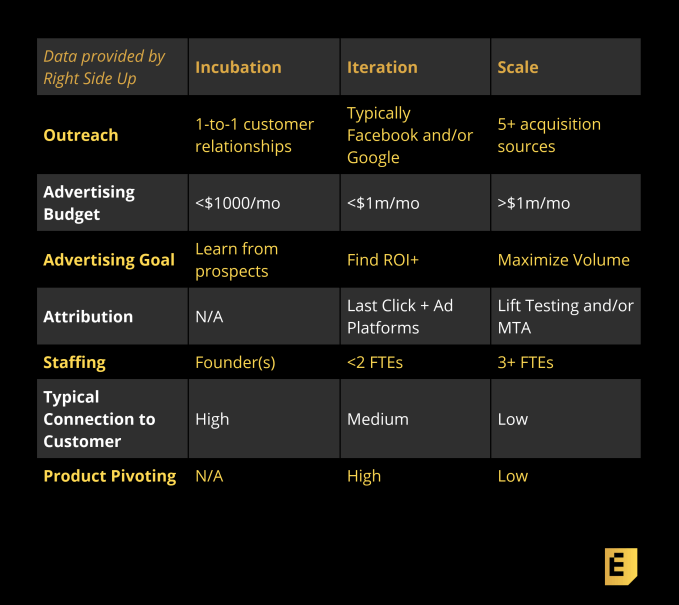Business
How should B2B startups think about growth? Not like B2C

Over the years, we’ve seen a lot of B2B companies apply ineffective demand generation strategies to their startup. If you’re a B2B founder trying to grow your business, this guide is for you.
Rule #1: B2B is not B2C. We are often dealing with considered purchases, multiple stakeholders, long decision cycles, and massive LTVs. These unique attributes matter when developing a growth strategy. We’ll share B2B best practices we’ve employed while working with awesome B2B companies like Zenefits, Crunchbase, Segment, OnDeck, Yelp, Kabbage, Farmers Business Network, and many more. Topics covered include:
- Descriptions of growth stages you can use to determine your company’s status
- Tactics for each stage with specific examples
- Which advertising channels work best
- Optimization of your ad copy to maximize CTR and conversions
- Optimization of your sales funnel
- Measuring the ROI of your advertising spend
We often crack growth for companies that didn’t think it was possible, based on their prior experience with agencies and/or internal resources. There are many misconceptions out there about B2B growth, rooted in the misapplication of B2C strategies and leading to poor performance. Study the differences and you’ll develop a filter for all the advice you get that’s good for one context (ex: B2C) but bad for another (ex: B2B). This guide will get you off on the right foot.
Table of Contents
What growth stage is your B2B startup?
The best growth strategy for your company ultimately depends on whether you’re in an incubation, iteration, or scale stage. One of the most common mistakes we see is a company acting like they’re in the scale phase when they’re actually in the iteration phase. As a result, many of them end up developing inefficient growth strategies that lead to exorbitant monthly ad spends, extraneous acquisition channels, hiring (and later firing) ineffective team members, and de-emphasizing critical customer feedback. There is often an intense pressure to grow, but believing your own hype before it’s real can kill early-stage ventures. Here’s a breakdown of each stage:

Incubation is when you are building your minimum viable product (MVP). This should be done in close partnership with potential customers to ensure you are solving a real problem with a credible solution. Typically a founder is a voice of the customer, as someone who experienced the problem and sought out the solution s/he is now building. Other times, founders enter a new space and build a panel of prospective buyers to participate in the product development process. The endpoint of this phase is a working MVP.
Iteration is when you have customers using your MVP and you are rapidly improving the product. Success at this stage is rooted in customer insights – both qualitative and quantitative – not marketing excellence. It’s valuable to include in this iterative process customers with whom the founder(s) have no prior relationship. You want to test the product’s appeal, not friends’ willingness to help you out. We want a customer set that is an accurate sample of a much larger population you will later sell to. The endpoint of the iteration phase is product/market fit.
Scale is when you have product/market fit and are trying to grow your customer base. The goal of this phase is to build a portfolio of tactics that maximize market penetration with minimal – or at least profitable – cost. Success is rooted in growing lifetime value through retention and margin, maximizing funnel conversion to efficiently convert leads to customers, and finding repeatable tactics to drive prospective buyers’ awareness and consideration of your product. The endpoint of this phase is ultimately market saturation, leading to the incubation and iteration of new features, customer segments, and geographies.
How do you find B2B customers?
Here’s a list of B2B customer acquisition tactics we commonly employ and recommend. Later in this article, we’ll connect each channel to the growth stage it’s best used in. This list is generally sorted by early stage to later stage:
1. Leveraging your network. This is particularly valuable for founders who are building a product based on their own past experience.
- Reach out to old colleagues you know have the same problem you had (and are solving).
- Leverage the startup ecosystem. If your startup is in YCombinator, for instance, other companies in your batch may be prospects, along with alumni who will take your call simply because of your affiliation.
- Example: If you’re building an app for marketers, ask past marketing colleagues you’ve worked with to try out your product is a no brainer.
-

 Entertainment7 days ago
Entertainment7 days agoWhat’s new to streaming this week? (Jan. 17, 2025)
-

 Entertainment6 days ago
Entertainment6 days agoExplainer: Age-verification bills for porn and social media
-

 Entertainment5 days ago
Entertainment5 days agoIf TikTok is banned in the U.S., this is what it will look like for everyone else
-

 Entertainment5 days ago
Entertainment5 days ago‘Night Call’ review: A bad day on the job makes for a superb action movie
-

 Entertainment5 days ago
Entertainment5 days agoHow ‘Grand Theft Hamlet’ evolved from lockdown escape to Shakespearean success
-

 Entertainment6 days ago
Entertainment6 days ago‘September 5’ review: a blinkered, noncommittal thriller about an Olympic hostage crisis
-

 Entertainment6 days ago
Entertainment6 days ago‘Back in Action’ review: Cameron Diaz and Jamie Foxx team up for Gen X action-comedy
-

 Entertainment6 days ago
Entertainment6 days ago‘One of Them Days’ review: Keke Palmer and SZA are friendship goals
















